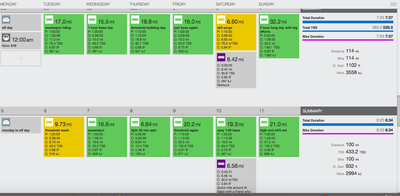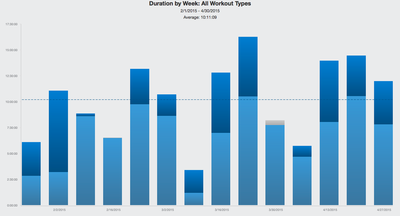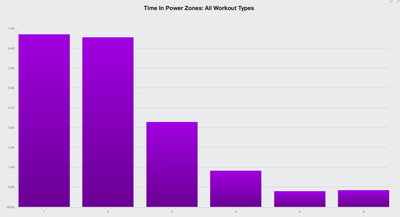As part of this series we have discussed starting to ride, methods to build fitness, and goal setting for your own specific purposes. Now we get into some of the meat and potatoes of training as we create a specific approach to your goals and what you want to get out of all this. Below you will find information on when to work easy, hard, specifically, and without a focus. After all, training should be specific to you and you should have the understanding of how to do so!
Periodization of Training
Depending on who you ask, you will come to find there are different blocks to each season. Generally speaking, these can be broken into off-season, pre-season, season, and post-season. Based on which part of the overall cycle you are in will determine how specific you should be in your training. An example of an athlete I coach can be seen below for season periodization
Dec 1-April 15: Pre-Season (building fitness)
April 16-August 31: Season (peak performances taking place)
Sept 1-Oct 1: Post-Season (fitness is trending down, but still competitive)
Oct 2- Nov 30: Off-season (body and mind are recovering)
It is important to know that the time of year can change based on your desired peak performance. In general though, a pre-season or base period should consist of 4-5 months, season with peak performance should consist of 2-4 months, post-season should be roughly 1 month and then your off-season is around 1-2 months. Based on your individual preferences and how your body reacts to training will determine how long each of these blocks are in your yearly training cycle.
Training All the Time
After discussing periodization, I hope that you can see there is a designed off-season when the focus shouldn’t be on performance. The ramifications of focusing on performance year around can be overtraining or burnout if you aren’t careful. Overtraining is a symptom that results in injuries to the body in the form of tendonitis, micro-fractures, and any other stress related injury that requires you to take time off. If you are lucky enough to avoid overtraining, you still could experience burnout which is an injury to the mind. This is when you feel the overall stress to perform at an optimal level but no longer can achieve the fulfillment of a workout. When this happens your mind starts to shut off and you begin to resent the activity as a whole and find no reason to continue. This is extremely detrimental to your performance and will often sideline athletes for months or even years. I hope you are starting to see the need for an off-season and overall decline in fitness. This decline in fitness will result in the motivation and desire to regain your performance and come back even stronger the next year.
Specific Training with Periodization
Specific training is key to peaking for your optimal success. That being said, you need to be aware that you can’t peak year-round and you really only have 2-3 shots to get it right each training cycle (year). Therefore, you need to understand when specific training should take place and when it shouldn’t. But before we go into those details, we need to understand your training zones for specific training
Training Zones
Your training zones are generally developed in regards to your threshold. If you are on a bike and using a power meter, then generally speaking your threshold is the amount of watts you can hold for 1 hour. If you are using a heart rate monitor, then a good test to use is a 30 minute 100% effort where you take the last 20 minutes average heart rate and classify that as your threshold. Once you have either of these numbers, then a general way to break these down are:
Zone 1: 0-60% Recovery
Zone 2: 60-75% Aerobic Endurance
Zone 3: 75-90% Tempo
Zone 4: 90-105% Threshold
Zone 5: 105-120% Aerobic Capacity
Zone 6: 120-135% Anaerobic Capacity
Zone 7: 135+ Neuromuscular
Note: These zones are more specific to cycling, but rather close for heart rate as well. There are different zones you can utilize for heart rate that could prove more effective for your own personal ability/fitness. (Karvonen Formula or other methods)
Example of zones with a 300 watt threshold
zone 1: 0-180 watts
zone 2: 181-225 watts
zone 3: 226-270 watts
zone 4: 271 -315 watts
zone 5: 316-360 watts
zone 6: 361-405 watts
zone 7: 405+ watts
When you start to develop your own personal zones, you can start to get very specific.
Specific Training
We are going to assume that our example athlete is looking to do time trials (40km) on their bike. This is how we would specifically train them utilizing their zones and periodization. Their main event will be the state time trial championship in late July.
Pre-season: 4-5 months in this case from Jan-the beginning of May. So starting on Jan 1 we would focus not on intensity or volume just yet, but rather frequency (see week 2 blog) to build them in a safe an effective manner with reduced risk of injury. Our training zone shouldn’t be specific to race day just yet because we can only peak 2-3 times a year and we want to save that. Therefore, this racer is going to do a lot of z2/3 work for the first 2-3-4 months in order to develop a strong aerobic base in which to work.
As we start to get closer to season, we need to understand that the race demand for this athlete will be a lot of threshold due to the race lasting roughly 1 hour and some aerobic capacity to help the athlete when they need to make surges over a bridge or coming out of a turn. This athlete won’t need much anaerobic power (30-90 seconds) and it will only be put in the training to spice up the training from the mental perspective. Some won’t hurt, but a lot won’t help.
So, we have the cyclist who has done a lot of z2/3 time and once a frequency of 5-6x a week was established, we started to add in volume to increase fitness. Now we are getting close to the actual season and we are going to start adding in specific intensity to build fitness and the ability to perform at the desired race. As we get closer and closer to race day we will advance the length of the intervals in the desired performance zone (zone 4: threshold) and build the body’s ability to remove lactate from the muscles while under stress at a certain level.
The build of z4 training may look like
May: 6x4 min z4, 5x5 min z4
June: 3x10 min z4, 2x20 min z4
July: 2x20 min z4 (creeping into z5) 1x40 min z4 with every 5th minute adding a z5 minute
As we near the competition, we will overload the athlete with a high amount of stress and then back off training and let the racer recover for the amount of time needed. This is when the athlete will peak in their specific training for threshold results and have a great race day at the event.
Post-Season: The athlete will more than likely be tired mentally from the extreme specific training. This is normal and to be expected. This is the part of the season where fitness will still be high and racing should take place as the athlete sees fit. You don’t want to press the athlete in this portion of the season as burnout or overtraining can take place. A great example of this is when a Professional rider wins the Giro but can’t podium at the Tour de France. This is because they peaked their fitness for the Giro and couldn’t maintain those levels for another big race. Again, this is normal and to be expected. You’ll still be fast during this time, but you won’t be 100%. Training zones to follow during this time should be back to z1/2/3 and at the riders discretion.
Off-season: This is where fitness is brought back down for the body to recover and the athlete to take care of other things in their lives. Training zones here are at the riders discretion but the coach should keep an eye on total workload. The coach is keeping an eye on workload so the athlete is properly recovering and they aren’t going to peak to early next season.
Theory of Specificity
I just want to put this in here because a lot of people ask me if they can get faster on the bike from lifting weights. The theory of specificity states that you only get better at what you are specifically training. Therefore, when doing squats or lunges, you are not utilizing the muscles of the legs in the same way that you would if you were riding a bike. While doing squats and lunges will help in balancing out the muscles and preventing injury, you aren’t going to increase your threshold by 40 watts if you increase your squat by 40 pounds. That simply isn’t how it works unfortunately. Train for how you want to compete!
Conclusion:
This was a lot of information for a blog, but its one of the most important aspects to get right for optimal race-day performance. By periodizing your schedule and training specifically for a goal you are in a far better place to perform to your peak ability. I hope this proved useful for your idea on how to tackle this winter and what you should be doing when. Next week we will get more involved with heart rate and power training and how effective it can be for time crunched athletes.



 RSS Feed
RSS Feed
